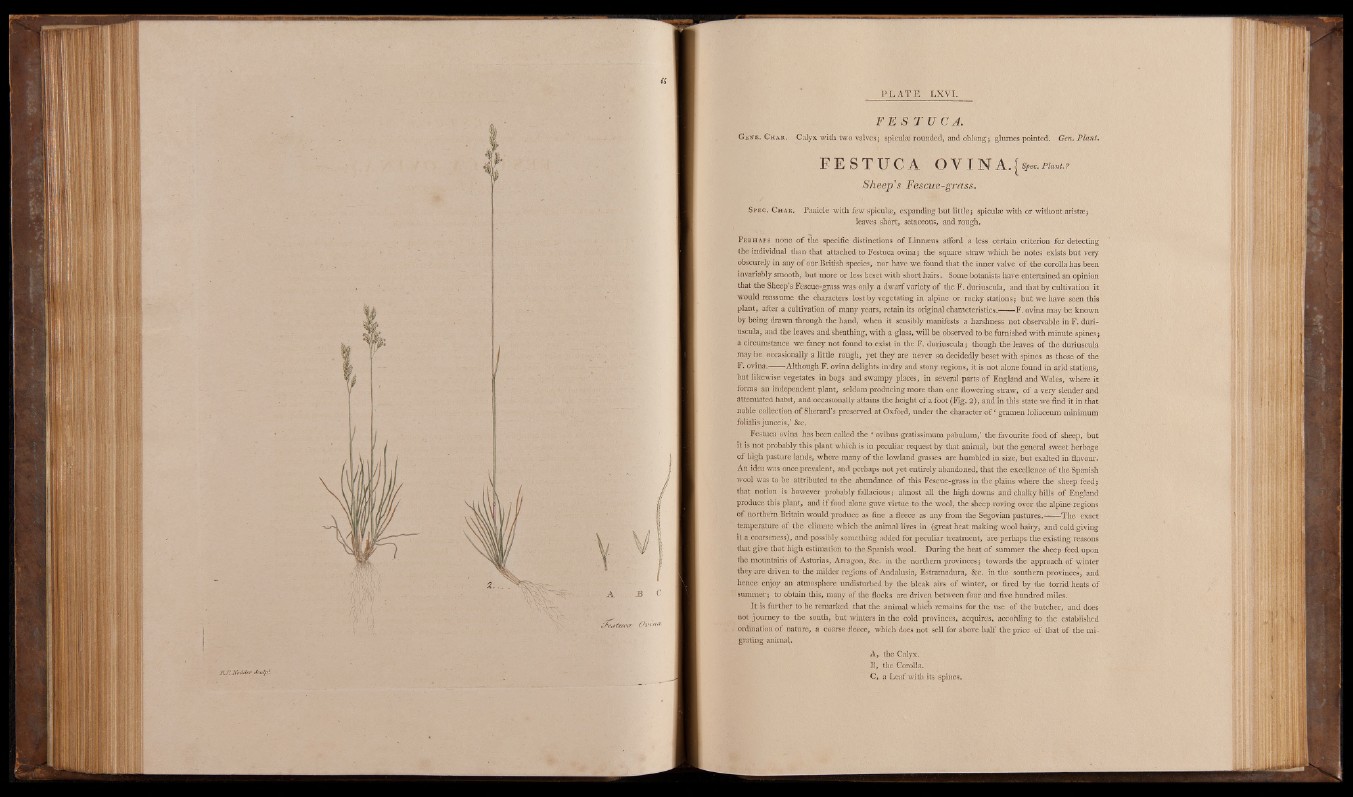
F E S r u e A.
Gene. Char. Calyx with two valves j spiculse rounded, and oblongj glumes pointed. Gen. Plant.
FE STUC A OVINA.{s/e,
Sheep's Fescue-grass.
Spec. Char. Panicle with few spiculas, expanding but little■, spiculse with or without aristsej
leaves short, setaceous, and rough.
Perhaps none of the specific distinctions o f Linnaeus afford a less certain criterion for detecting
the individual than that attached to Festuca ovina j the square straw which he notes exists but very
obscurely in any o f bur British species, nor have w e found that the inner valve of the corolla has been
invariably smooth, but more or less beset with short hairs. Some botanists have entertained an opinion
that the Sheep’s Fescue-grass was only a dwarf variety o f the F. duriuscula, and that by cultivation it
would reassume the characters lost by vegetating in alpine or rocky stations; but we have seen this
plant, after a cultivation of many years, retain its original characteristics.——F. ovina may be known
by being drawn through the hand, when it sensibly manifests a harshness not observable in F. duriuscula,
and the leaves and sheathing, with a glass, will be observed to be furnished with minute spines j
a circumstance we fancy not found to exist in the F. duriuscula j though the leaves of the duriuscula
may be occasionally a little rough, yet they are never so decidedly beset with spines as those of the
F. ovina.------Although F. ovina delights in dry and stony regions, it is not alone found in arid stations,
but likewise vegetates in bogs and swampy places, in several parts of England and Wales, where it
forms an independent plant, seldom producing more than one flowering straw, of a very slender and
attenuated habit, and occasionally attains the height of a foot (Fig. 2), and in this state we find it in that
noble collection o f Sherard’s preserved at Oxford, under the character o f ' gramen loliaceum m in im um
folialis junceis,’ &c.
Festuca ovina has been called the | ovibus gratissimum pabulum,’ the favourite food of sheep, but
it is not probably this plant which is in peculiar request by that animal, but the general sweet herbage
of high pasture lands, where many o f the lowland grasses are humbled in size, but exalted in flavour.
An idea was once prevalent, and perhaps not yet entirely abandoned, that the excellence o f the Spanish
wool was to be attributed to the abundance o f this Fescue-grass in the plains where the sheep feed •,
that notion is however probably fallacious; almost all the high downs and chalky hills o f England
produce this plant, and if food alone gave virtue to the wool, the sheep roving over the alpine regions
of northern Britain would produce as fine a fleece as any from the Segovian pastures.------ The exact
temperature of the climate which the animal lives in (great heat making wool hairy, and cold giving
it a coarseness), and possibly something added for peculiar treatment, are perhaps the existing reasons
that give that high estimation to the Spanish wool. During the heat o f summer the sheep feed upon
the mountains of Asturias, Arragon, &c. in the northern provinces j towards the approach of winter
they are driven to the milder regions of Andalusia, Estramadura, &c. in the southern provinces, and
hence enjoy an atmosphere undisturbed by the bleak airs of winter, or fired by the torrid heats of
summer j to obtain this, many of the flocks are driven between four and five hundred miles.
It is further to be remarked that th e animal which remains for the. use of the butcher, and does
not journey to the south, but winters in the cold provinces, acquires, accofrding to the established
ordination of nature, a coarse fleece, which does not sell for above half the price of that of the migrating
animal.
A, the Calyx.
B, the Corolla.
C, a Leaf with its spines.